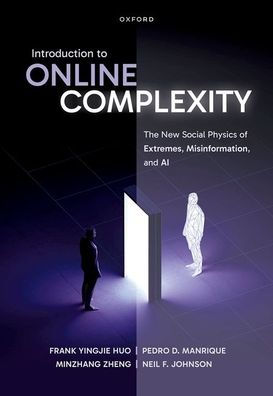Introduction to Online Complexity: The New Social Physics of Extremes, Misinformation, and AI
Today's online and offline world is an immensely complex system. We see numerous surprising "black swan" events emerging, yet it is hard to make sense of them. This book attempts to quantitatively address many of these phenomena from the perspective of physics. Physics is used as a tool to model interactions and provide potential control schemes to complex systems.
The new science of systems interacting including heterogenous humans, technology, and Artificial Intelligence (AI) is an exciting prospect, with applications ranging from space missions through to new medical procedures. Introduction to Online Complexity lays out the new science of these systems with an aim to help equip the next generation of physicists and other scientists with knowledge of what to expect, how such systems can be described quantitatively, and what tools could be used to design behaviours or mitigate undesired behaviours.
This book operates as both a source book and a textbook for this deeply interesting new physics.
1147560209
The new science of systems interacting including heterogenous humans, technology, and Artificial Intelligence (AI) is an exciting prospect, with applications ranging from space missions through to new medical procedures. Introduction to Online Complexity lays out the new science of these systems with an aim to help equip the next generation of physicists and other scientists with knowledge of what to expect, how such systems can be described quantitatively, and what tools could be used to design behaviours or mitigate undesired behaviours.
This book operates as both a source book and a textbook for this deeply interesting new physics.
Introduction to Online Complexity: The New Social Physics of Extremes, Misinformation, and AI
Today's online and offline world is an immensely complex system. We see numerous surprising "black swan" events emerging, yet it is hard to make sense of them. This book attempts to quantitatively address many of these phenomena from the perspective of physics. Physics is used as a tool to model interactions and provide potential control schemes to complex systems.
The new science of systems interacting including heterogenous humans, technology, and Artificial Intelligence (AI) is an exciting prospect, with applications ranging from space missions through to new medical procedures. Introduction to Online Complexity lays out the new science of these systems with an aim to help equip the next generation of physicists and other scientists with knowledge of what to expect, how such systems can be described quantitatively, and what tools could be used to design behaviours or mitigate undesired behaviours.
This book operates as both a source book and a textbook for this deeply interesting new physics.
The new science of systems interacting including heterogenous humans, technology, and Artificial Intelligence (AI) is an exciting prospect, with applications ranging from space missions through to new medical procedures. Introduction to Online Complexity lays out the new science of these systems with an aim to help equip the next generation of physicists and other scientists with knowledge of what to expect, how such systems can be described quantitatively, and what tools could be used to design behaviours or mitigate undesired behaviours.
This book operates as both a source book and a textbook for this deeply interesting new physics.
60.0
Pre Order
5
1

Introduction to Online Complexity: The New Social Physics of Extremes, Misinformation, and AI
288
Introduction to Online Complexity: The New Social Physics of Extremes, Misinformation, and AI
288Hardcover
$60.00
60.0
Pre Order

Product Details
| ISBN-13: | 9780198921011 |
|---|---|
| Publisher: | Oxford University Press |
| Publication date: | 12/30/2025 |
| Pages: | 288 |
| Product dimensions: | 6.50(w) x 1.50(h) x 9.50(d) |
About the Author
From the B&N Reads Blog
